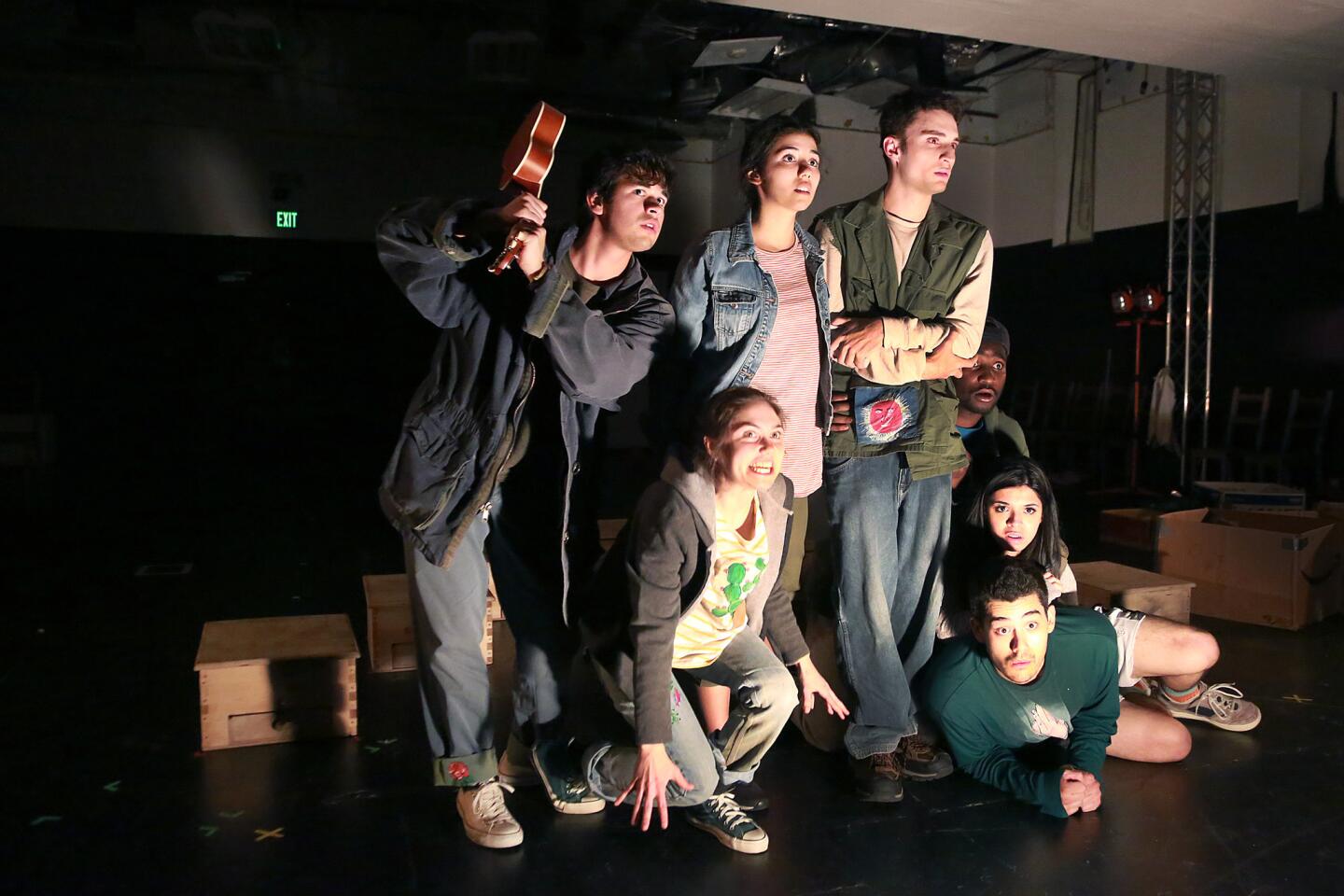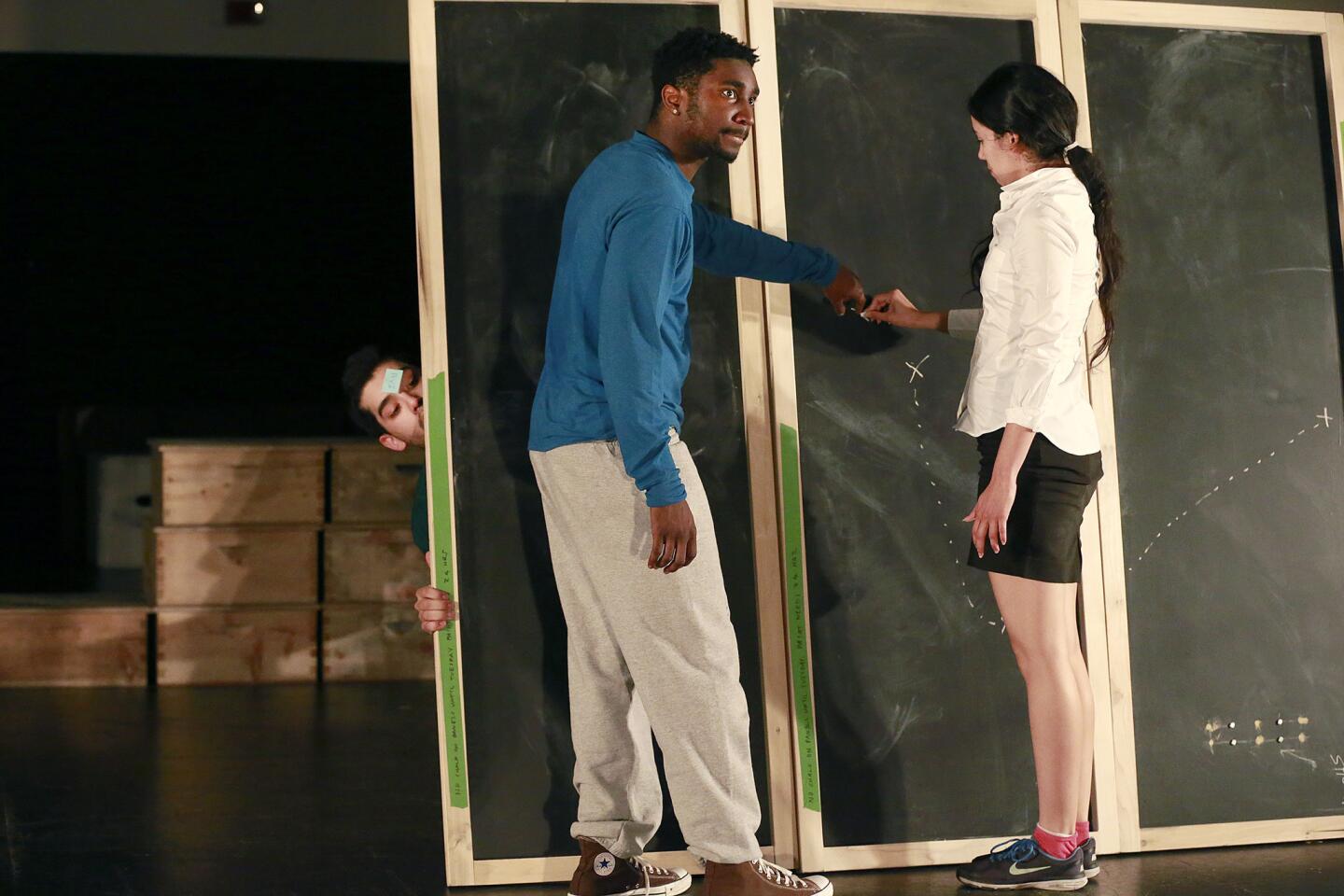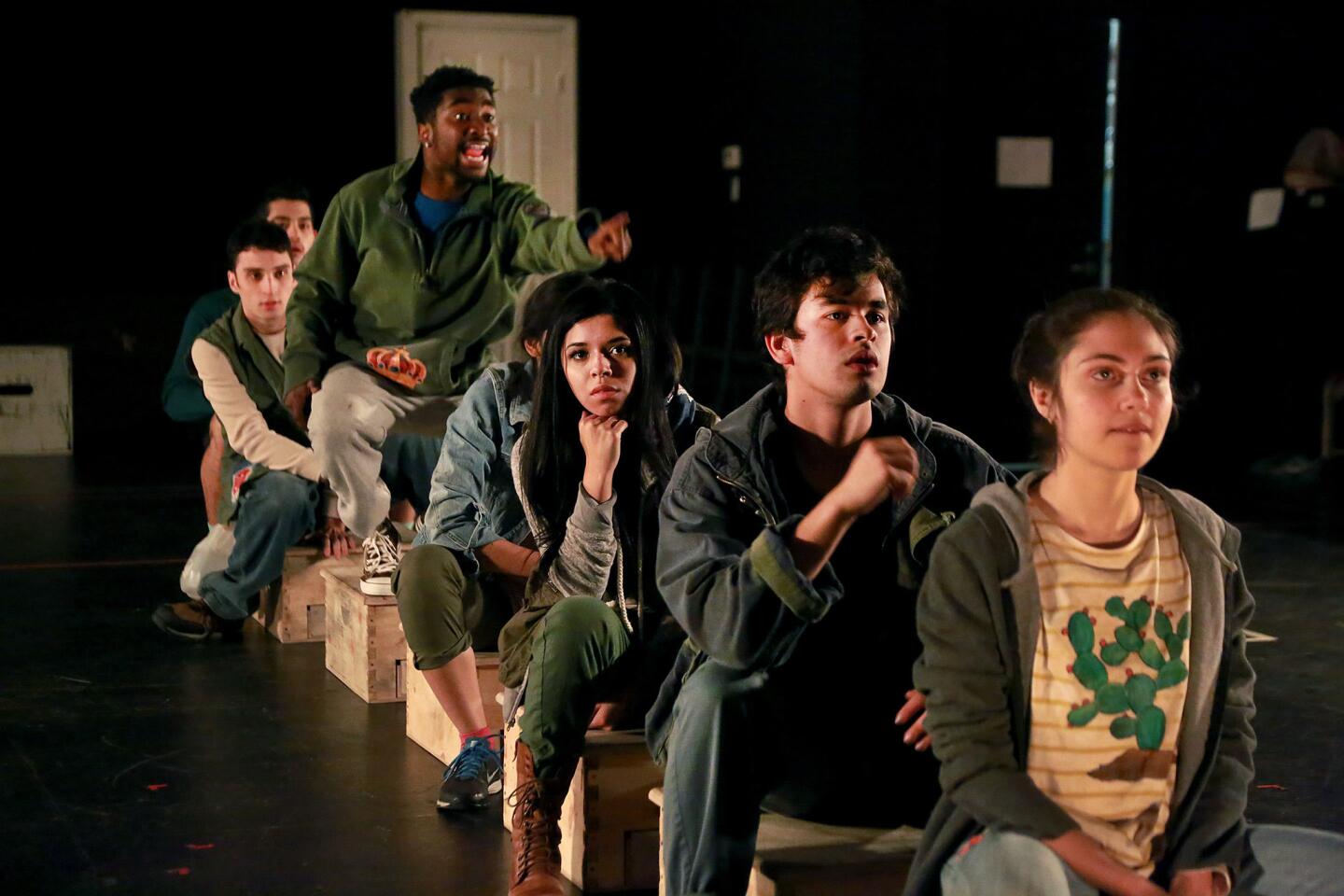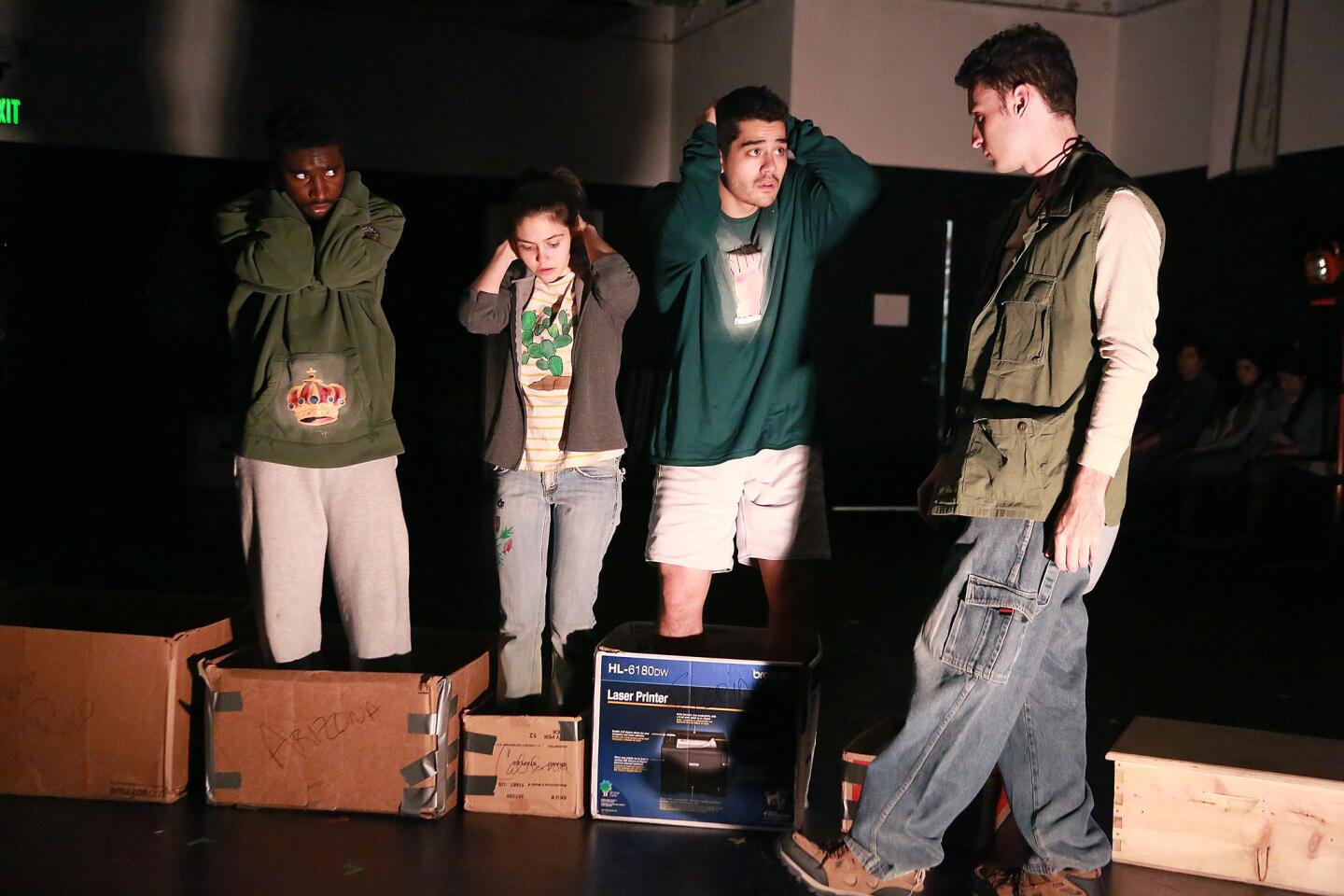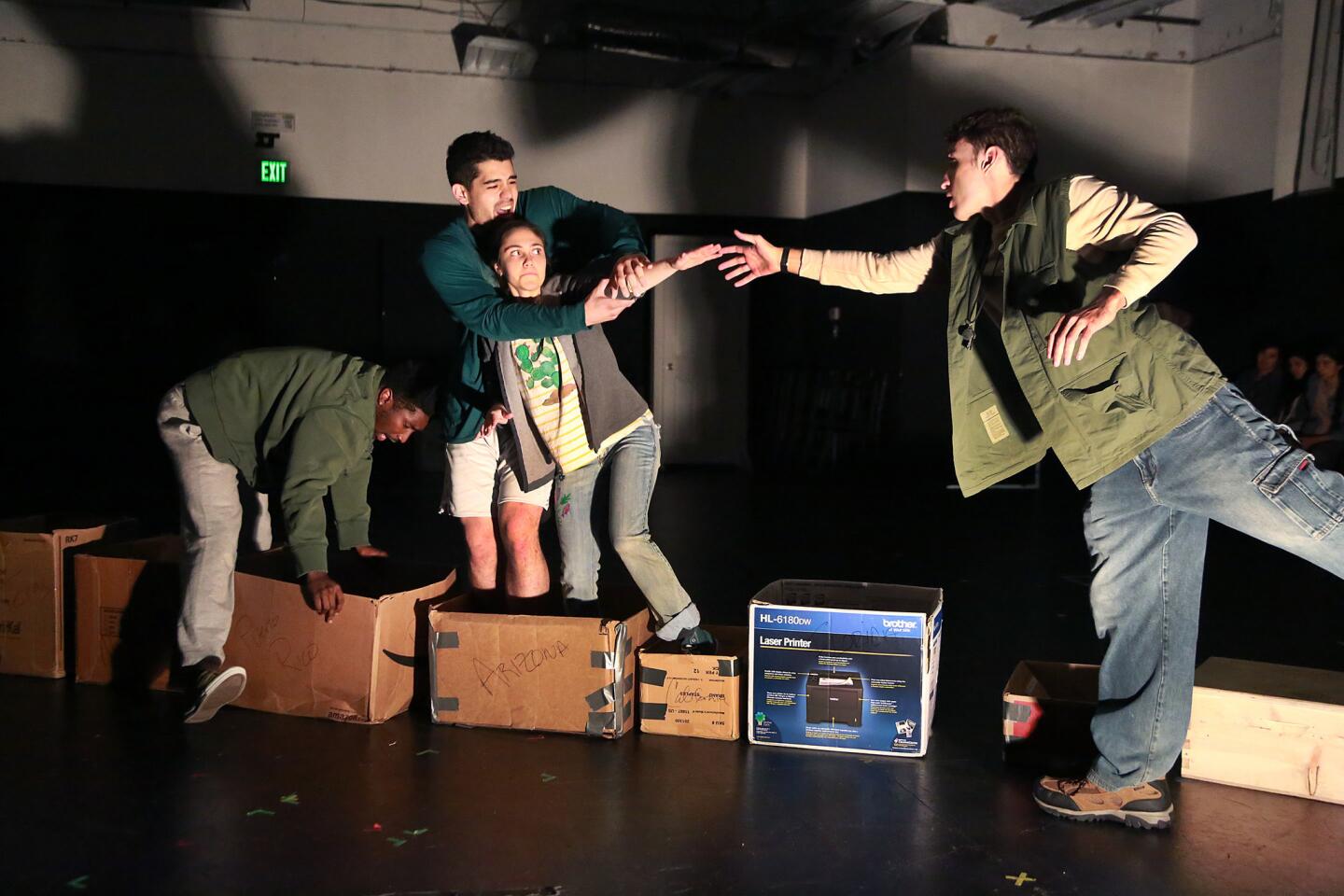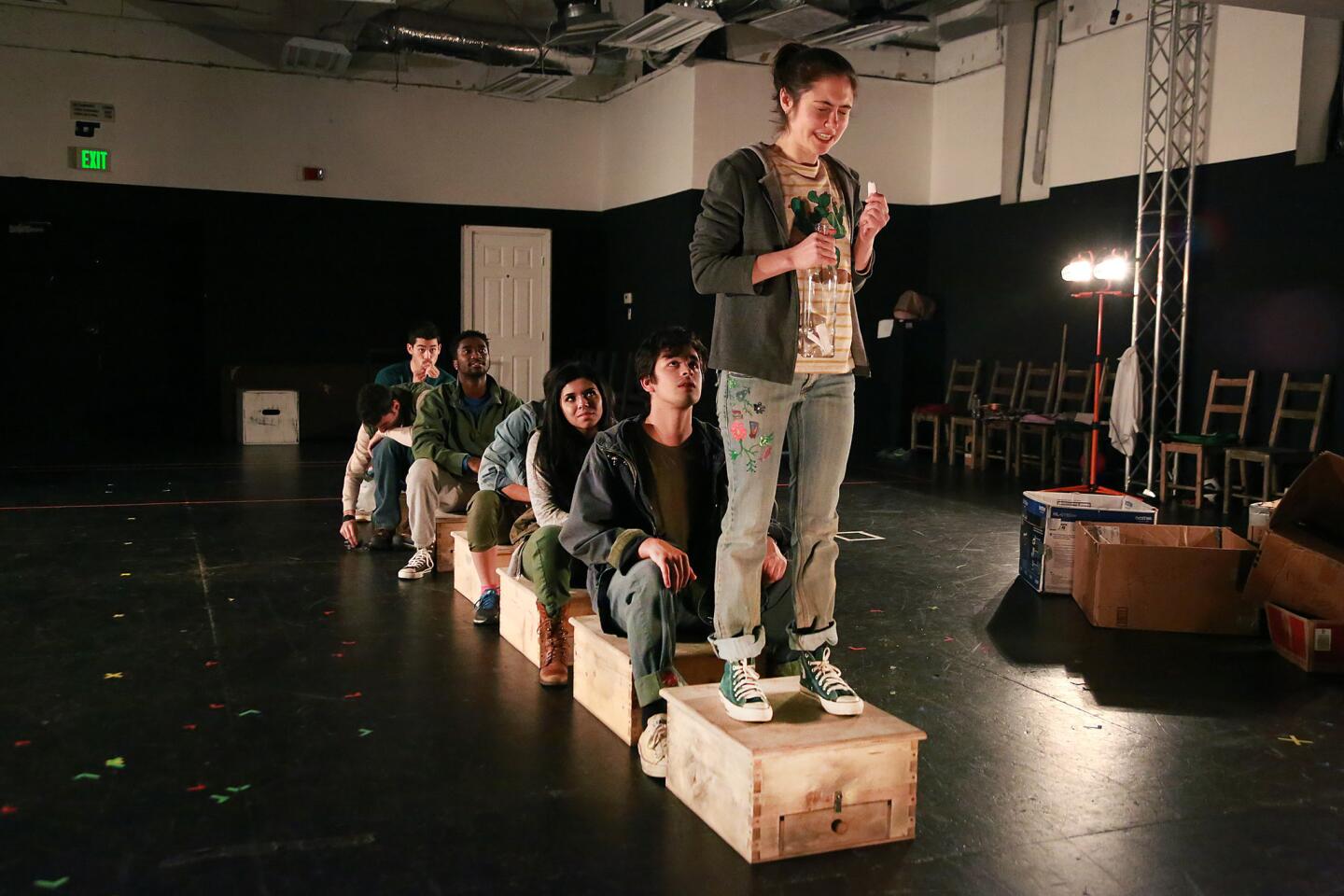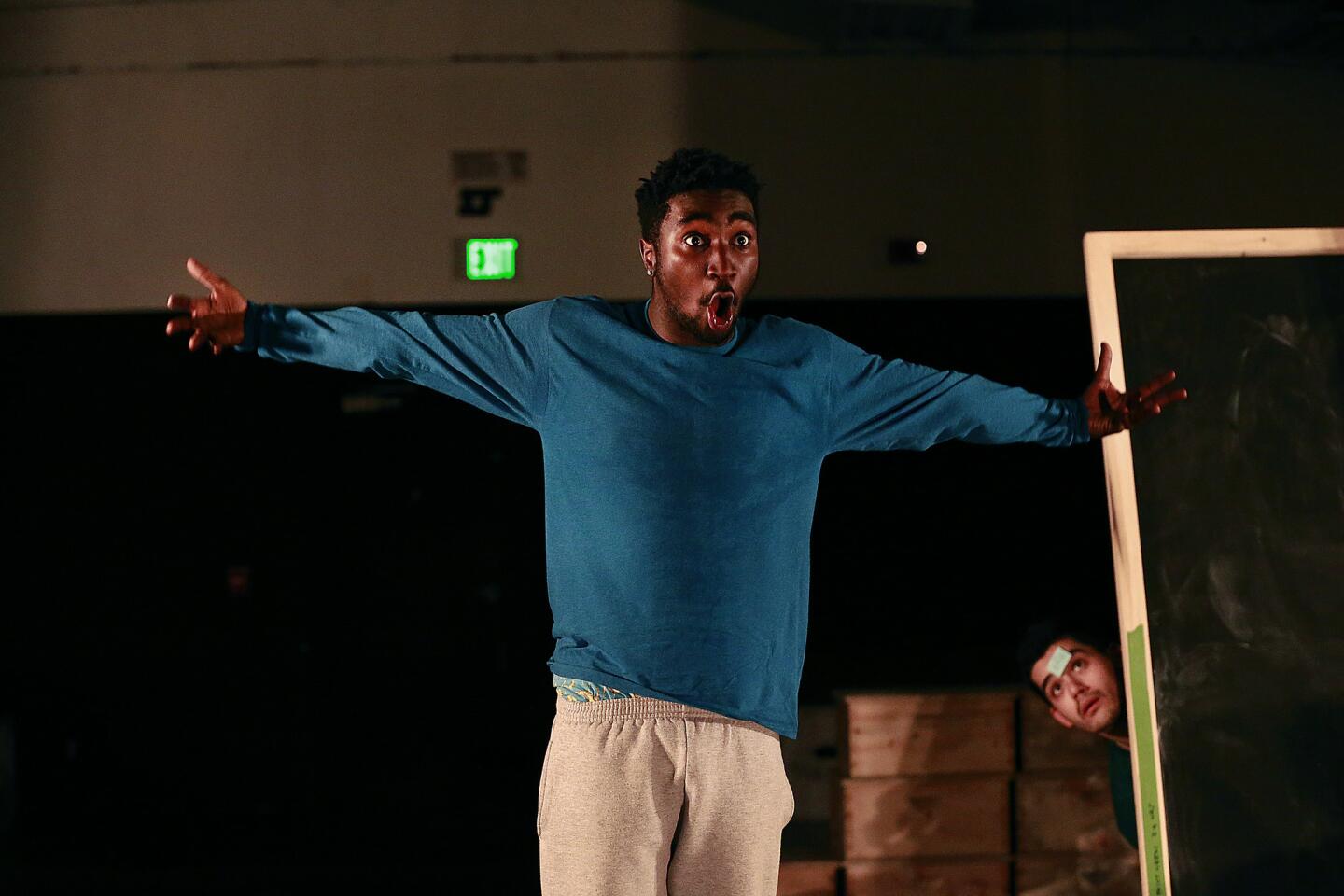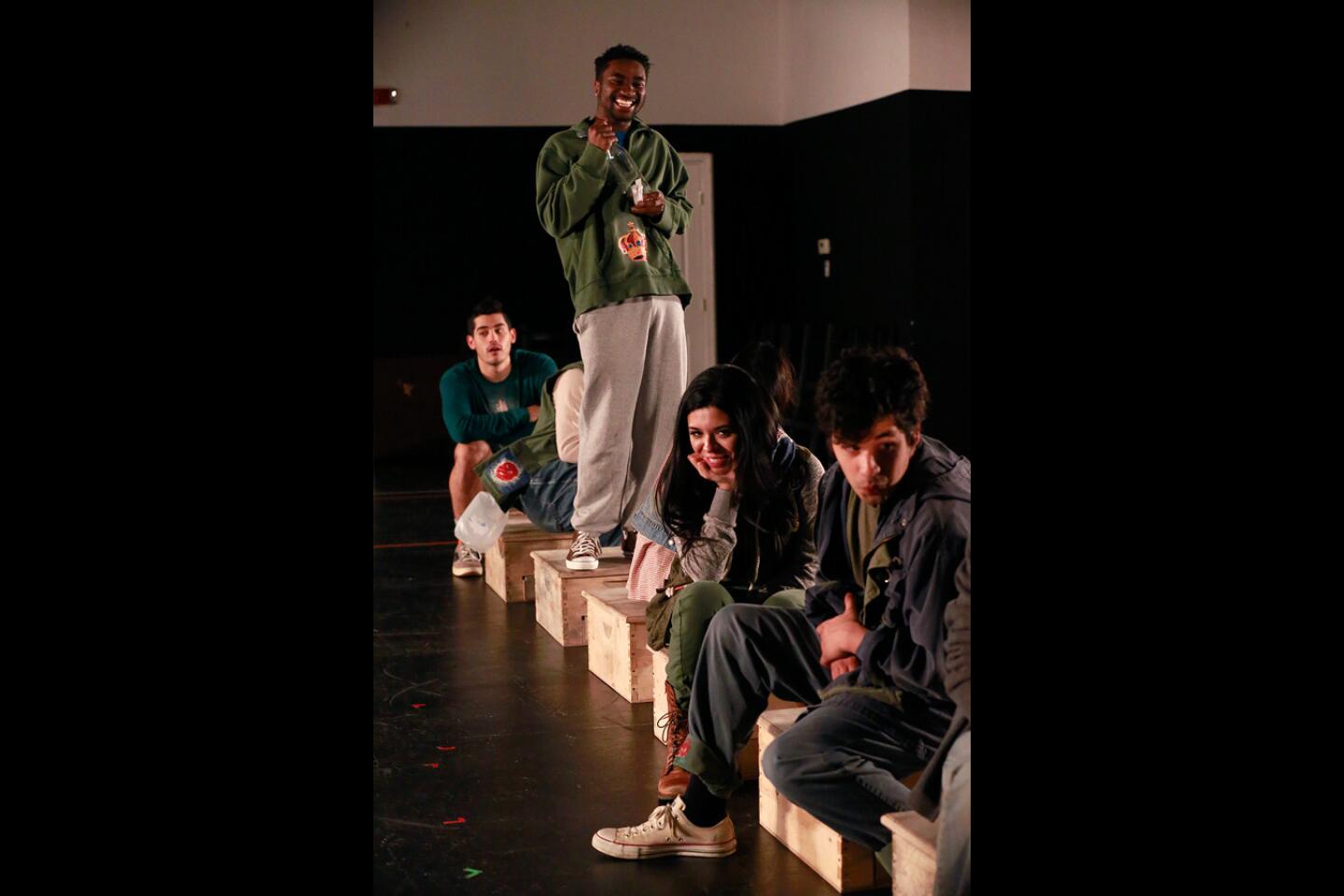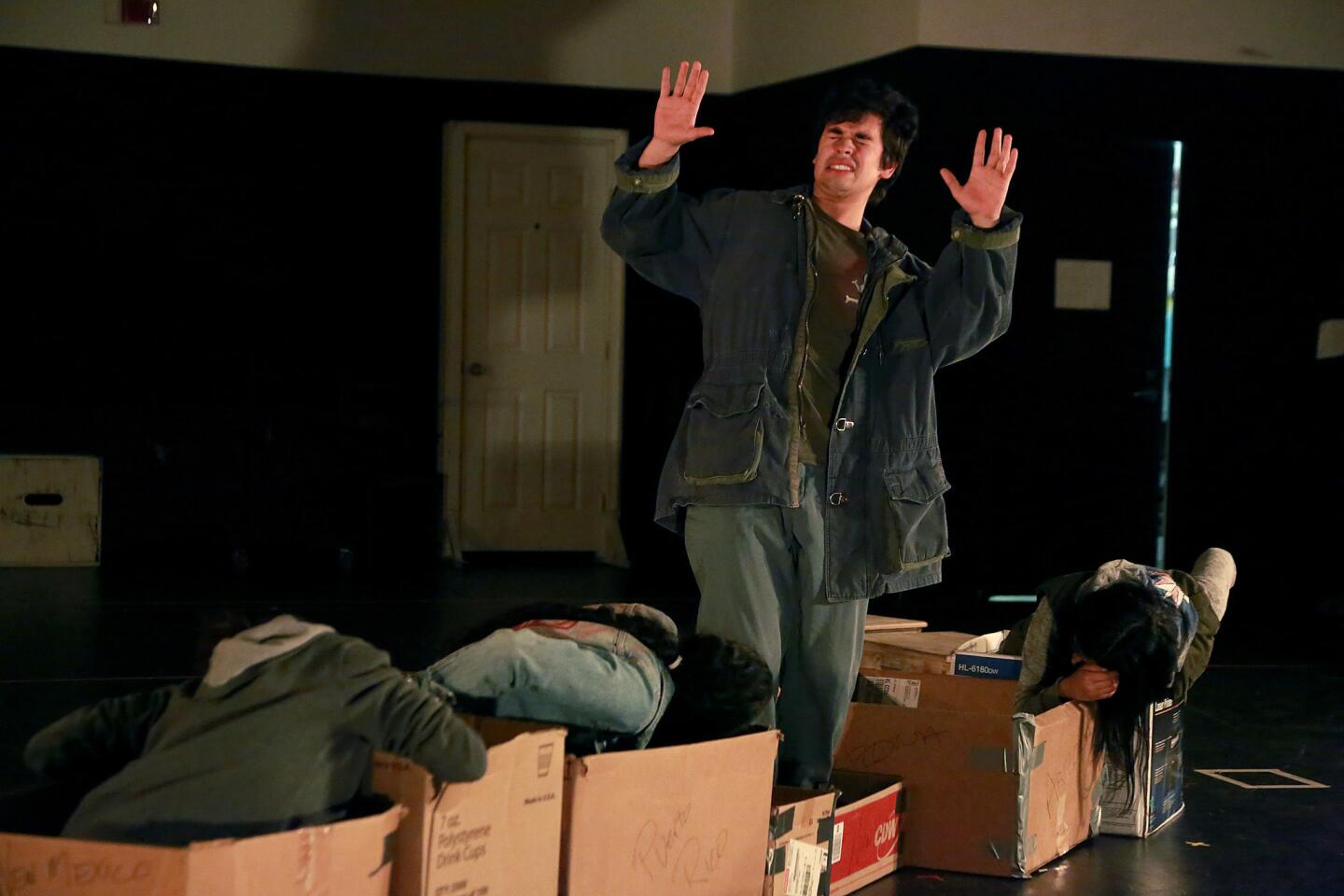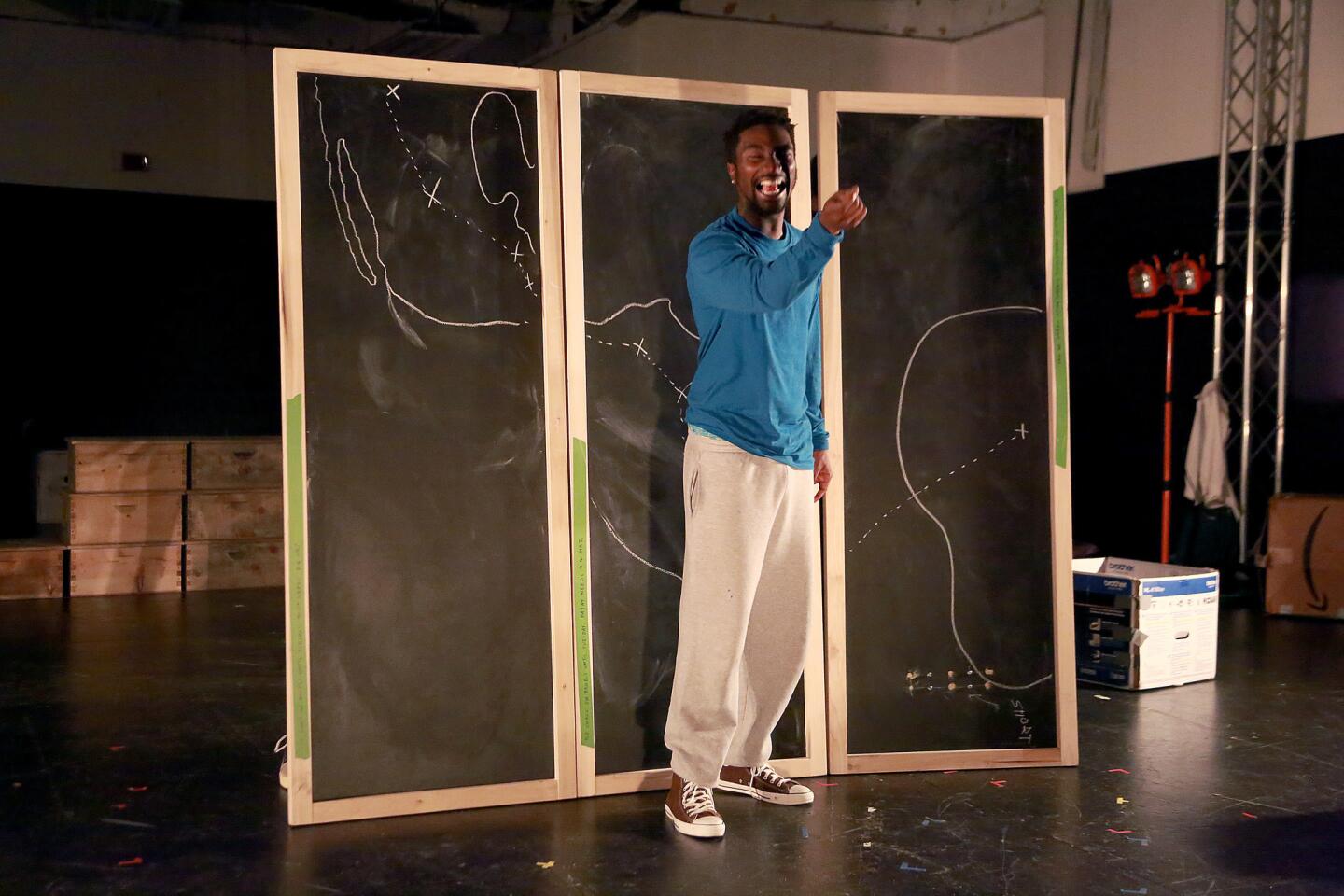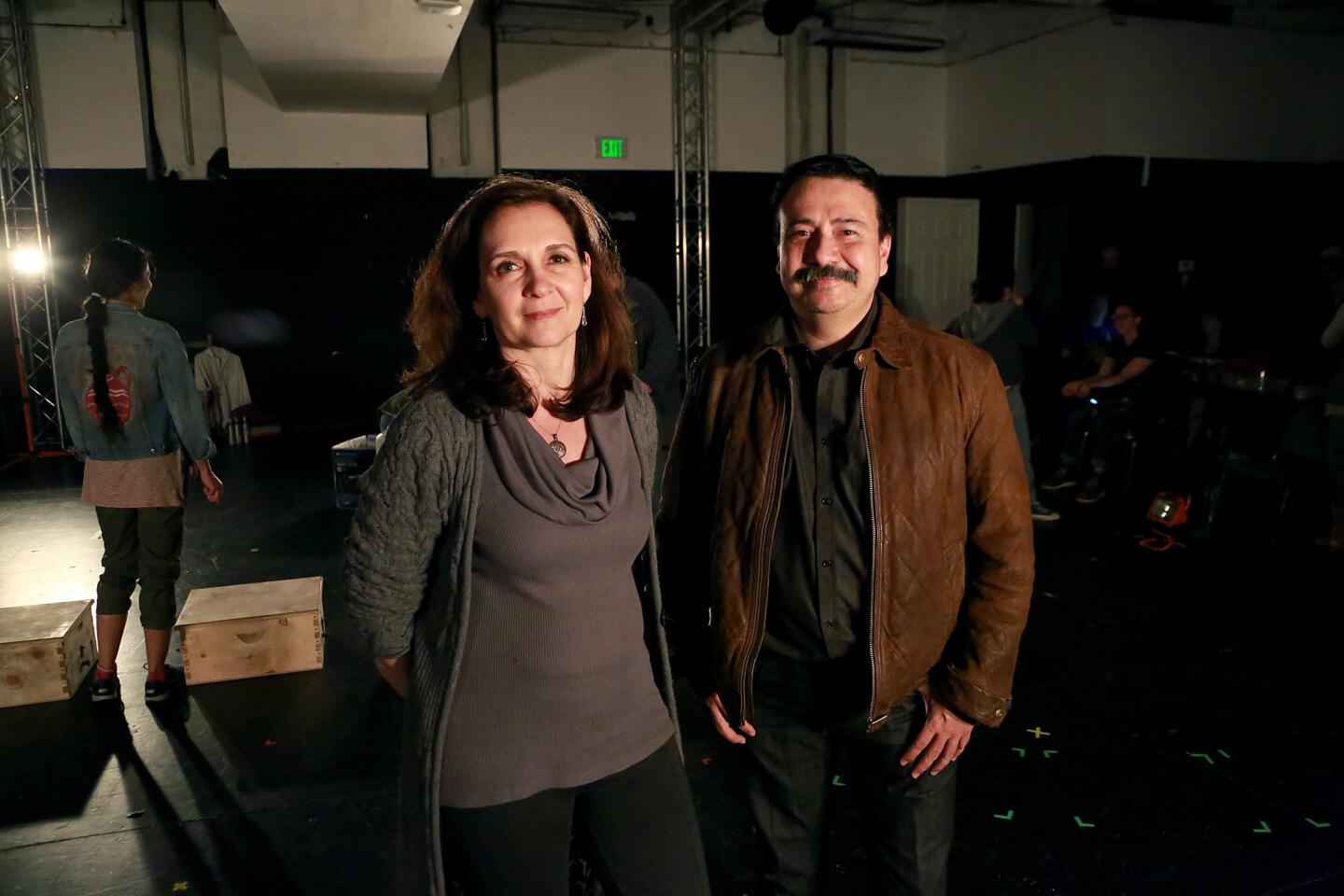CalArts’ ‘Shelter’ gives voice to the Central American kids fleeing to the U.S. without their parents
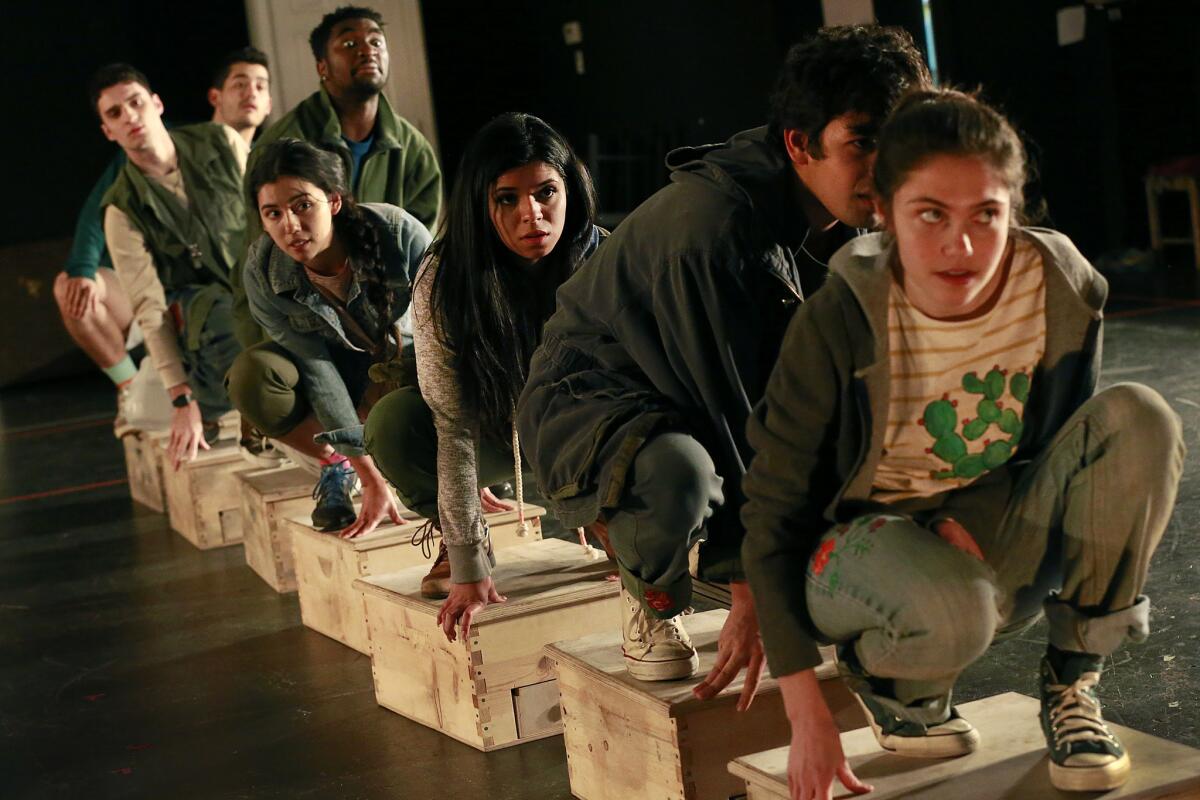
Cast members of CalArts rehearse “Shelter,” a play that is a movement-based performance which tells the stories of unaccompanied minors crossing the U.S. border and passing through the deportation shelter system.
- Share via
The stage is sparse but for seven plywood boxes, lined up like train cars and bathed in the golden light of dusk. One by one, the kids climb atop the boxes, which rumble and shake beneath their feet, as if the cargo train they’re perched on were careening forward. Balancing themselves against the unsteadiness, the teenagers face the audience and brazenly declare their dreams for when they cross the Mexican-U.S. border:
“I want to be a teacher. The kind that kids look up at with this face,” says Jasmin, with an expression of awe.
“A doctor who also does rap. To keep my patients happy,” says Poncho.
“I want the life I decide. Without them telling me how to think, what I have to do,” says Ernesto.
As they reveal their ideal futures, each character slips a paper wish into a glass bottle.
“I want to see my mother in San Antonio,” Ernesto adds, eyes glassy with tears. “May God watch over our journey and bless it with his blood.”

“Shelter - una obra sobre travesías,” is a play about unaccompanied minors crossing from Central America into the United States and going through the shelter system. The play opens in Los Angeles at Lincoln Park on April 8, 2016.
The rehearsal, in a theater space at the California Institute of the Arts in Valencia, is for “Shelter,” a new production giving voice to the thousands of Central American children trying to escape violence each year in their countries by making their way to the U.S. without parents or guardians. The piece, written by CalArts faculty member Marissa Chibas and directed by Mexico-based Martin Acosta, conveys children’s tragic stories of riding the treacherous “La Bestia” freight trains — from which migrants risk falling off or losing limbs or getting kidnapped and forced into Mexican drug cartels or the sex trafficking trade. The production also follows characters navigating the American immigration and youth shelter systems afterward.
Presented by CalArts’ Center for New Performance and featuring all CalArts actors, “Shelter” opens April 8 at Lincoln Park in the Lincoln Heights neighborhood of L.A.
Chibas — native New Yorker, daughter of Cuban refugees and now acting teacher at CalArts — says that in 2013 she became disturbed by the media coverage of unaccompanied Central American youths seeking refuge in the United States. Much of the wording in the news stories, she says, was clinical and heavily numbers-based.
“I was horrified by what these kids were going through and the focusing on the numbers,” Chibas says. “You know, ‘60,000 kids!’ And strange words like ‘swarms coming.’ I thought, ‘Whoa,’ there’s a human story here that I wasn’t reading about. So that’s really what propelled me.”
Chibas spent more than a year doing research, including interviewing Central American immigrant children now attending Glassell Park’s School of History and Dramatic Arts as well as immigration rights volunteers at a San Diego youth shelter.
Some of the high school students Chibas had talked with sat in as she, Acosta and their actors workshopped “Shelter” at CalArts.
“I really wanted them to feel the power of their stories being told,” Chibas says. “They were incredibly moved. Immediately, some of them were crying. One of them said: ‘I feel represented.’”
Seven actors play multiple roles and channel those stories as well as the experiences of the children’s lawyers and caseworkers throughout the four chapters of “Shelter.” One chapter conveys the children’s train journey; another delves into the historical roots of the issue.
Chibas had read Sonia Nazario’s book, “Enrique’s Journey,” based on her Pulitzer Prize-winning 2002 Los Angeles Times series of the same name that chronicled one boy’s travels from Honduras to the U.S. Another chapter of “Shelter” relays different perspectives on immigration, as told through reader comments to a 2014 Nazario article published in the New York Times. Chibas said it was important to present multiple viewpoints on immigration because it’s such a controversial topic and not everyone will sympathize with the plight of these children or even see them as refugees.
“Some people say, ‘These are not refugees, it’s not our problem.’ Others say, ‘This is our problem — because who’s buying the drugs that’s creating this war?’” Chibas says, referring to a key source of violence in the children’s native countries.
For all its political and emotional heft, “Shelter” is purposefully minimal, with a pared set and little dialogue. That’s because the production is meant to be as populist as theater gets. It’s performed in English and Spanish, it’s free, and it comes in two versions: a staged rendition with a set designed by Boyle Heights native Efren Delgadillo Jr., and a more portable, stripped-down version, with a set consisting mainly of cardboard boxes and chairs, to be performed in community centers, schools and parks.
The Lincoln Park run is the fuller, staged version, featuring Delgadillo’s “poetic statement” of a set: a 20-foot shipping container-turned-boxcar that has graffiti on the outside and is lighted from within. The actors perform in, on and around it. And when the engagement ends, “everything in the production goes into the container and it loads up on a tow truck and gets hauled to its next location,” Delgadillo says.
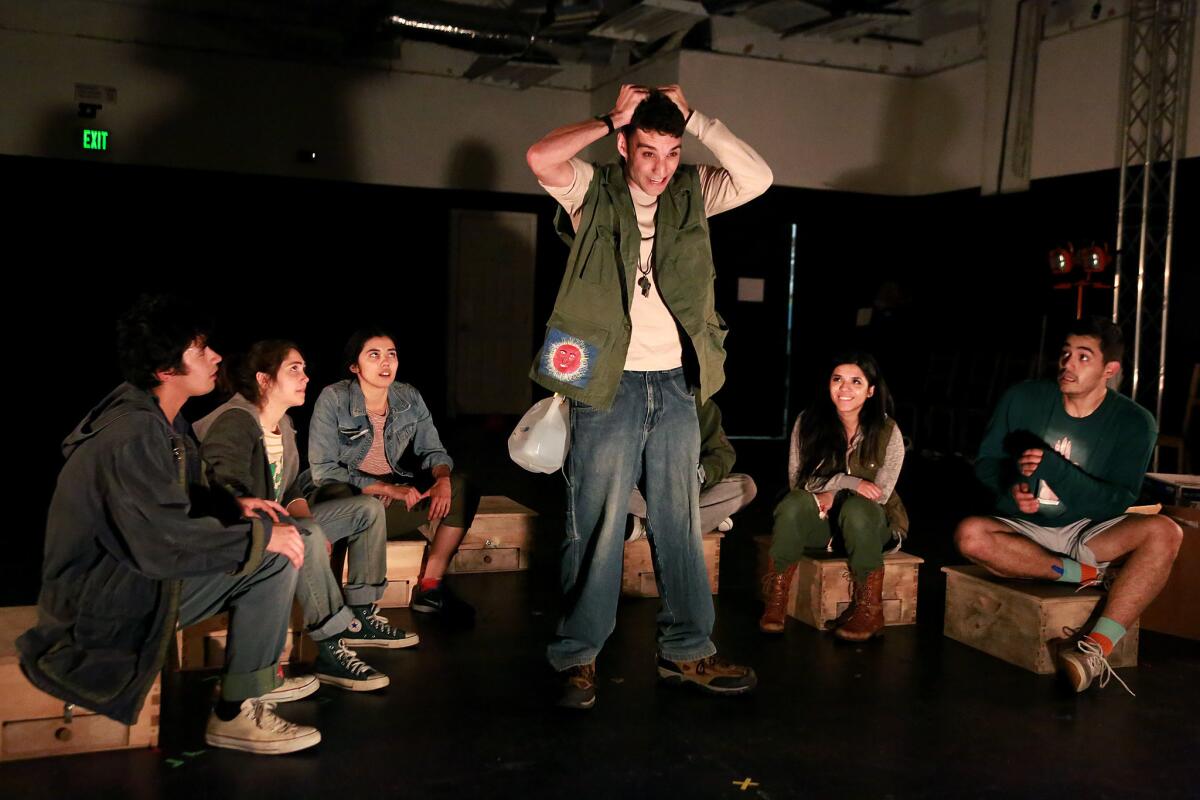
CalArts actors in “Shelter” rehearsal.
“Shelter” is a vehicle for education and personal development, Chibas says, as much a community engagement project as theater. Lectures, musical jams and talk-back sessions will be held before or after most Lincoln Park performances at the adjacent Plaza de la Raza. In February, Chibas held “I Too Am Somebody” empowerment workshops for high school kids at CARECEN, a Central American refugee support center near MacArthur Park, and at the School of History and Dramatic Arts. She hopes to lead more workshops in May.
“Recently, there’s been a lot of hate talk about immigrants,” Chibas says. “And I see the effects on the bodies of young people, a kind of carrying of shame. So we constructed these workshops focusing on how important it is to carry a proud body.”
Keeping “Shelter” surprisingly lighthearted, even funny at times, was of the utmost importance to Acosta.
“I didn’t want to talk about this in a very tragic tone,” Acosta says. “It’s from the point of view of the kids. So I wanted it to feel childlike, almost like a game, like an epic adventure for them.”
Even the shifting between English and Spanish is purposefully random, Acosta says, not following any narrative logic. “It should be like a dream, a stream of consciousness,” he says.
Instead, the “movement-based theatrical performance,” as it’s described, is especially visual, with flickering strobe lights conveying the children’s violent dreams and choreographed pantomime helping to make the narrative clear, even if one doesn’t understand the language being spoken.
One section, without any words at all, is particularly visceral and moving. It’s a slow-motion sequence on the train. The action is jerky, broken into shards of movement by overhead strobe lights; only the click-clicking of an old-fashioned movie camera is audible. A character slowly falls off the train as kids look on, horrified. Then the actors freeze and the click-click-clicking lingers, for punctuation. As the train passes through a small town, a local resident tosses sandwiches to the starving children, who catch them in the air with outstretched arms. Click-click-click. The result is haunting, graphic and sad — cinematic, even.
“This train is not free, you pay, believe me, you pay!” one unnamed character comments early on.
Acosta says he was intrigued by this topic, in part because “the children are invisible,” he says. “It’s a huge tragedy; they are dying in my country. And in Mexico, nobody talks about it.”
Acosta and Chibas hope “Shelter” will tour nationally, though they’re still working out the details. Scenes from the mobile version will take place at the Pasadena Playhouse on April 19 as part of a one-night PBS SoCal community engagement project; the entire mobile version will be performed June 22 at a national nonprofit theater conference, TCG, in Washington, D.C.
------------
For the Record
An earlier version of this article cited the date of the PBS SoCal project as April 18. It is April 19.
------------
The wider the audience, the better, says Emilio Garcia-Sanchez, 23, an actor in the production. He sees “Shelter” as “becoming the spearhead of this important subject matter.”
That means not only looking back at the roots of this immigration issue but also looking forward. The ability to dream, he says, cannot be underestimated.
“I come from a long line of people who have crossed that border multiple times,” says Garcia-Sanchez, who grew up in the Bay Area. “These kids were just like me when I was a kid — just having dreams, wanting a better future. Giving those dreams a voice has been the most fulfilling part of this for me.”
Twitter: @debvankin
More to Read
The biggest entertainment stories
Get our big stories about Hollywood, film, television, music, arts, culture and more right in your inbox as soon as they publish.
You may occasionally receive promotional content from the Los Angeles Times.

